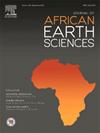Petrogenesis of migmatites from Liman Katagum area (Bauchi) North-East Nigeria: Constraints from U-Pb and Lu-Hf isotopic data
IF 2.2
4区 地球科学
Q2 GEOSCIENCES, MULTIDISCIPLINARY
引用次数: 0
Abstract
This study investigates the petrogenesis and tectonic evolution of migmatites from the Liman Katagum area in northeast Nigeria. In-situ Lu-Hf isotopic analyses of zircon reveal a complex source history, with εHf(t) values ranging from −13.43 to +8.95 at different ages (482 ± 120 Ma, 582.2 ± 9.0 Ma, and 498 ± 43 Ma). These values suggest contributions from both ancient reworked and juvenile crustal materials, spanning the Chondrite Uniform Reservoir (CHUR) and various crustal domains, indicating significant crustal recycling and juvenile additions. High zircon U/Yb ratios, along with elevated Y and Hf, reflect a strong continental arc affinity, supporting a crustal origin for the migmatites. Geochemical and morphological evidence, including enriched heavy rare earth elements (HREEs) and variable Th/U ratios, indicate both magmatic and metamorphic origins for the zircons, consistent with early Silurian arc magmatism. U-Pb zircon ages of 582.2 ± 9.0 Ma, 498 ± 43 Ma, and 482 ± 120 Ma correspond to distinct tectonic events, including the Pan-African orogeny. The earliest stage, at 582.2 Ma, shows significant juvenile crustal input during continental arc magmatism in the Neoproterozoic. By 498 Ma, tectonic reactivation led to partial melting and zircon crystallization, while the final stage at 482 Ma is linked to high-pressure metamorphism and crustal thickening during the collision of the West African Craton and the Tuareg Shield. Two distinct zircon age groups (582.2 ± 9.0 Ma and 498 ± 43 Ma) reflect the reworking of the Paleoproterozoic and Mesoproterozoic crust, with substantial juvenile input. This tectonic evolution, initiated around 482 Ma, involved crustal thickening, metamorphism, and partial melting, forming migmatites. Continued tectonic activity around 582 Ma caused shear zone development and crustal reworking, while reactivation at 498 Ma led to the crystallization of new zircons and the formation of migmatites. This study, similar to migmatite studies across Africa, elucidates the dual-source history of the Liman Katagum migmatites, with contributions from both reworked and juvenile crustal materials during the late Neoproterozoic and Early Paleozoic, highlighting episodes of partial melting and magma intrusion associated with the breakup of Rodinia and the assembly of Gondwana.
尼日利亚东北部Bauchi地区Liman Katagum地区混合岩成因:来自U-Pb和Lu-Hf同位素数据的约束
本文研究了尼日利亚东北部Liman Katagum地区混合岩的岩石成因和构造演化。锆石原位Lu-Hf同位素分析显示锆石源史复杂,不同年龄(482±120 Ma、582.2±9.0 Ma和498±43 Ma)的εHf(t)值在−13.43 ~ +8.95之间。这些数值表明,古代和幼年地壳物质的贡献,跨越球粒陨石均匀储层(CHUR)和不同的地壳域,表明了显著的地壳再循环和幼年添加。锆石U/Yb比值高,Y、Hf值高,反映出大陆弧亲和性强,支持混合岩的地壳成因。富集的重稀土元素(hree)和变化的Th/U比值等地球化学和形态证据表明,锆石既有岩浆成因,也有变质成因,符合早志留世弧岩浆作用。U-Pb锆石年龄分别为582.2±9.0 Ma、498±43 Ma和482±120 Ma,对应不同的构造事件,包括泛非造山运动。最早阶段为582.2 Ma,显示新元古代大陆弧岩浆活动中有明显的幼年地壳输入。到498 Ma,构造活动导致部分熔融和锆石结晶,而最后阶段在482 Ma,与西非克拉通和图阿雷格地盾碰撞期间的高压变质和地壳增厚有关。两个不同的锆石年龄组(582.2±9.0 Ma和498±43 Ma)反映了古元古代和中元古代地壳的改造,其中有大量的幼石输入。这一构造演化始于482 Ma左右,涉及地壳增厚、变质和部分熔融,形成混杂岩。582 Ma前后持续的构造活动导致剪切带发育和地壳改造,而498 Ma的再活动导致新锆石结晶和杂岩形成。本研究与整个非洲的混闪岩研究类似,阐明了Liman Katagum混闪岩的双源历史,其中包括新元古代晚期和早古生代的再加工和新生地壳物质,突出了与Rodinia分裂和Gondwana合并相关的部分熔融和岩浆侵入事件。
本文章由计算机程序翻译,如有差异,请以英文原文为准。
求助全文
约1分钟内获得全文
求助全文
来源期刊

Journal of African Earth Sciences
地学-地球科学综合
CiteScore
4.70
自引率
4.30%
发文量
240
审稿时长
12 months
期刊介绍:
The Journal of African Earth Sciences sees itself as the prime geological journal for all aspects of the Earth Sciences about the African plate. Papers dealing with peripheral areas are welcome if they demonstrate a tight link with Africa.
The Journal publishes high quality, peer-reviewed scientific papers. It is devoted primarily to research papers but short communications relating to new developments of broad interest, reviews and book reviews will also be considered. Papers must have international appeal and should present work of more regional than local significance and dealing with well identified and justified scientific questions. Specialised technical papers, analytical or exploration reports must be avoided. Papers on applied geology should preferably be linked to such core disciplines and must be addressed to a more general geoscientific audience.
 求助内容:
求助内容: 应助结果提醒方式:
应助结果提醒方式:


